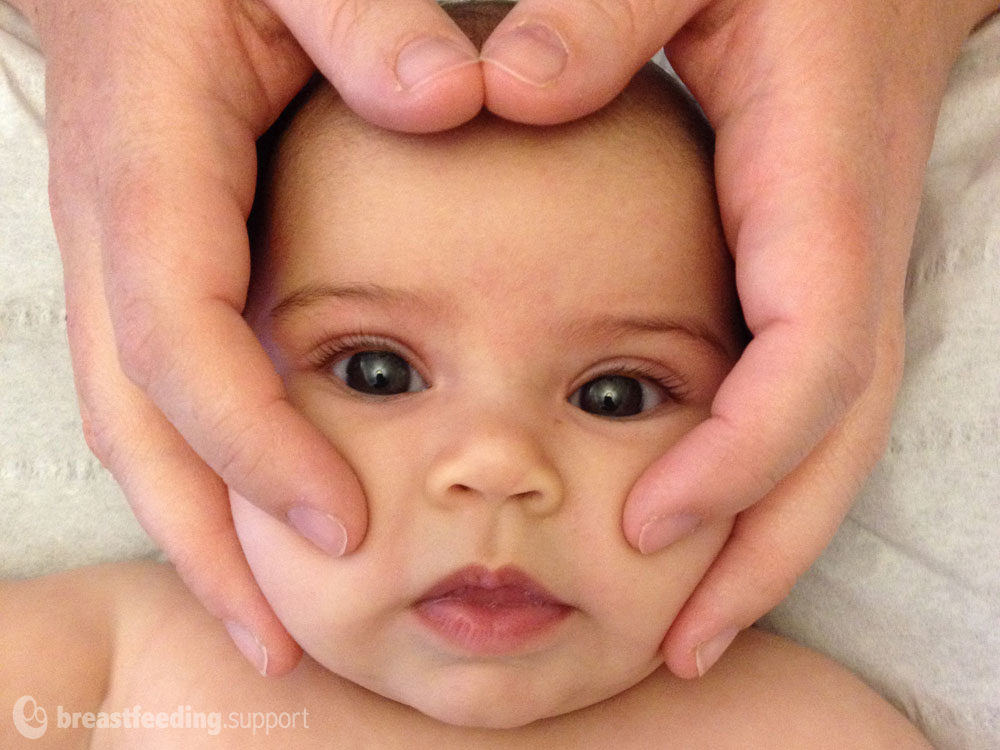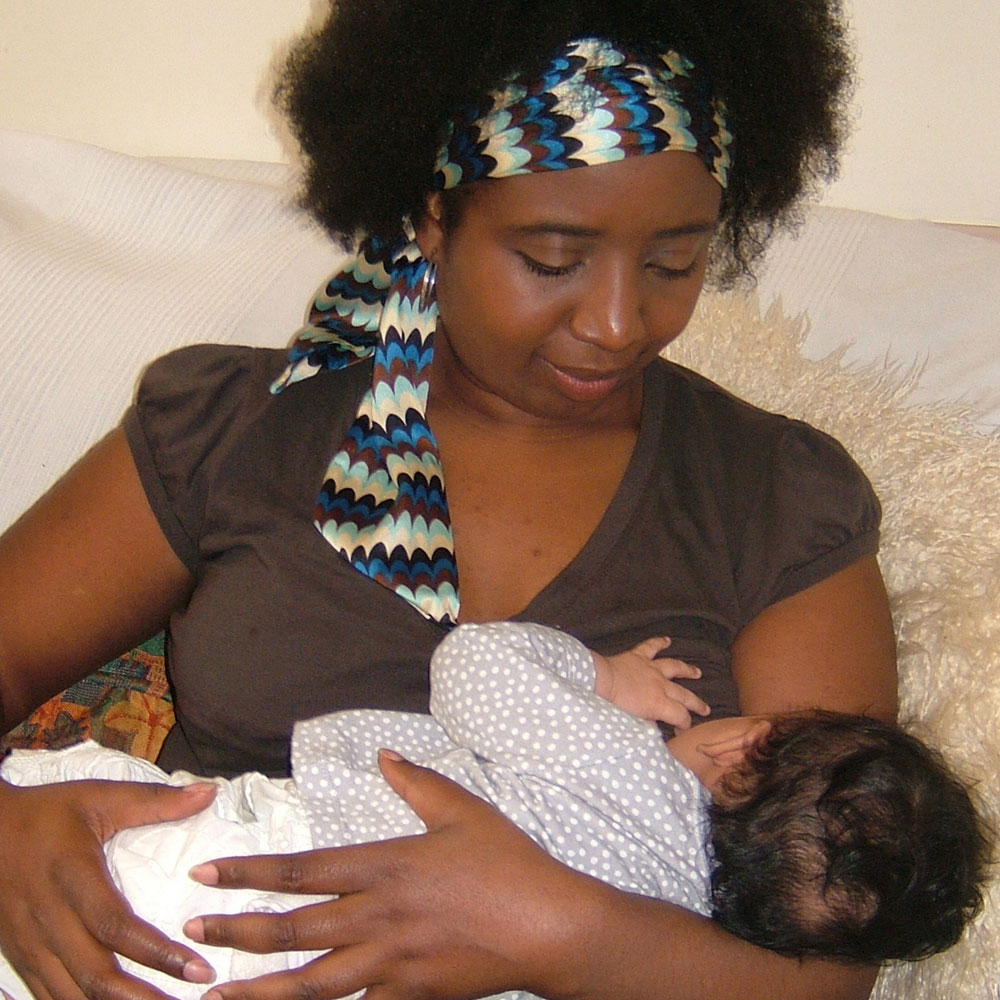Hands-on physical therapies including cranial techniques such as cranial osteopathy or craniosacral therapy are sometimes suggested for babies with breastfeeding or sucking difficulties. Online searches find anecdotal reports from satisfied parents who felt that this type of therapy, sometimes called bodywork, helped with their babies’ feeding or general comfort levels. Some people are sceptical and doubtful about cranial therapies and would like to see more evidence based research proving its safety record and benefits. This article looks at how cranial therapy might help breastfeeding issues in young babies, and directs parents to books and articles that offer more information.
What are cranial therapies?
- Cranial osteopathy is a specialised form of osteopathy that includes the anatomy and physiology of the head. A cranial osteopath looks for areas of strain or dysfunction by locating changes in tension and tissue quality in the body with their highly trained sense of touch. The cranial osteopath gently works on areas of tension with their hands and the treatment is said to be very relaxing.1
- Craniosacral Therapy (CST) is a similarly gentle, hands-on method of therapy using a very light touch. It is said to evaluate and enhance the craniosacral system in the body which is comprised of the membranes and cerebrospinal fluid that surround and protect the brain and spinal cord. The therapy claims to improve the functioning of the central nervous system, digestive, musculoskeletal, respiratory, and circulatory systems.2
For more information see Cranial Osteopathy or Craniosacral Therapy for my Baby?

How could cranial therapy help breastfeeding?
Dee Kassing, IBCLC has written an article describing how gentle physical therapies from experienced practitioners might help with sucking issues. Kassing explains that the bones in a baby’s skull are held together by flexible joints (sutures) so that they can move across each other to allow for squeezing down the birth canal. After birth the bones should move back into place but if they are not perfectly in line (often associated with forceps or ventouse delivery), this could affect the way the tongue and facial muscles work which in turn may irritate the nerves in the face. Kassing describes how this could affect suckling, swallowing and breathing:
If there is misalignment and imbalance of the skull bones, this can affect the function of the palate, tongue, and other structures of the head. This can cause the palate to be too high or uneven, or the facial muscles to be too tight. Imbalance of the structures of the head, as well as trauma from the birth process itself, can cause constant irritation to the nervous system. This constant irritation may also cause hypersensitivity, which can sometimes be the underlying cause for babies who gag and cannot accept anything in the centre or back of the mouth.
Rule out general breastfeeding difficulties first
Bear in mind that there can be many causes of feeding difficulties in the early days or weeks and they won’t all need bodywork or cranial therapy. Your IBCLC lactation consultant is the ideal breastfeeding specialist to check your baby’s latch (the way your baby attaches to the breast), breastfeeding position and tongue function—often simple changes to how you hold your baby to feed can resolve pain and soreness or help your baby improve their suckling technique. Sometimes self help measures such as skin-to-skin with your baby, tummy time or tongue exercises can help babies who are very tense—see High Muscle Tone for further information. A birth injury, an abnormality, a nervous system disorder or even the after effects of anaesthetics used during the birth can also cause difficulties with feeding and should be checked out with your qualified medical health professional.
When to consider physical assessment
Tow and Vallone 3 and breastfeeding author Cathy Watson Genna 4 recommend referral for a physical assessment (neuromusculoskeletal evaluation) in the following circumstances:
- If there was a birth injury or bruising around baby’s head, if labour was prolonged or if baby seems in any physical discomfort to feed
- If baby has a tongue-tie (a tight membrane restricting the tongue)
- If baby’s face is not symmetrical, or he uses his muscles asymmetrically
- If baby has an abnormal head shape, narrowing of the face, a receding chin or high palate
- If baby has a preference to turn his head to one side only or if his mother complains of pain on one nipple only
- If baby seems unable to move his head and neck or limbs freely or unable to hold his head in a neutral position
- If baby’s normal reflexes—rooting, suckling, gaping—are absent or exaggerated
- If baby is clamping, biting or chewing the nipple, sucking in his lips, slurping, unable to open his mouth wide or is walking up the nipple (called an incremental latch)
- If there is any bunching or thrusting of the tongue, arching away from the breast, pulling on and off breast, spilling milk at the breast, making clicking sounds or losing suction
- If baby doesn’t breastfeed for comfort or is unable to stay latched, only feeds passively (not actively) or keeps falling asleep after a short time at the breast.
Other causes
As noted above, there can be more than one cause for some of the symptoms in the above list. For example a baby who keeps falling asleep during a breastfeed might not be getting enough milk and not gaining weight; he may need more milk instead of worrying about the pros and cons of body work. A baby who has missing reflexes may have a neurological problem and should be assessed by your baby’s doctor or a paediatrician. A baby who seems to be biting the nipple may need help to breastfeed with a bigger mouthful of breast (deeper latch), and pulling on and off the breast or fussing can have a number of possible causes related to feeding. An IBCLC lactation consultant can help identify difficulties associated with breastfeeding technique or management.
Cranial therapy and the tongue
If the membrane under the baby’s tongue (called the lingual frenulum) is very short and ties the tongue tip to the bottom of the mouth it may make breastfeeding more difficult for some babies. When tongue movement is severely restricted this is called a tongue-tie and the membrane can be released in a quick procedure called a frenotomy. Published books on tongue-tie and breastfeeding increasingly include sections on the ways physical therapies can help with tongue function including before and after a frenotomy.56
Bodywork before and after tongue-release
Alison Hazelbaker, PhD, IBCLC, CST, RCST is a lactation consultant and craniosacral therapist. In her book Tongue Tie Morphogenesis, Impact, Assessment and Treatment, 2010 Hazelbaker explains how craniosacral therapy may help improve tongue function before and/or after tongue-tie release (frenotomy). She says that before a frenotomy, cranial therapy can optimise the structural alignment of the mouth, throat and thorax (chest area) and make sure there are no functional tongue restrictions unrelated to the frenulum. Cranial work after the frenotomy, says Hazelbaker, can speed healing, strengthen muscles, and help the communication between nerves and muscles that co-ordinate suck and swallow.
More effective suckling uses less calories
Catherine Watson Genna BS, IBCLC is an International Board Certified Lactation Consultant in private practice in New York City. In her book Supporting Sucking Skills, Cathy discusses how hands-on therapy (also referred to as manual therapy) can help normal function be restored in any structures that may not be working optimally due to injury or disturbance. When all the muscles and nerves associated with feeding are working as they should, a baby will suckle more effectively rather than burning extra calories by using inefficient compensations:
a nursing neonate can burn more calories feeding inefficiently than taken in during the feeding. A qualified manual therapist could help the baby suckle more effectively, thus encouraging the body to use those calories for growth, rather than suckling.
What are alternatives to cranial therapies?
There are several forms of hands-on therapy/bodywork that may be helpful to resolve any physical issues affecting breastfeeding including physiotherapy in mainstream medicine or even baby massage. It is important to find a very skilled therapist with experience of breastfeeding babies and one who is registered with their professional association. Ask other parents for their recommendations or ask your baby’s doctor for a referral. See Cranial Osteopathy or Craniosacral Therapy for my Baby? for further information and a comparison between those two types of treatment.
What does research say?
There doesn’t appear to be much reliable research evaluating how effective cranial therapies are 78 and most of the information available seems to be case reports submitted by practitioners 9. A recent article in the Journal of Human Lactation 10 concluded that an osteopathic treatment in conjunction with a lactation consultation could reduce biomechanical sucking difficulties in babies under six weeks of age however it also stated there was no significant difference in nipple pain between the control and treatment groups.

Summary
Cranial therapies and body work are sometimes said to be helpful for babies with breastfeeding or sucking difficulties. Some mothers notice a marked improvement in breastfeeding comfort after these therapies. Some parents feel their baby’s personality changed with therapy, from being tense and fussy to calm and happy—finally being able to sleep peacefully. Others don’t notice any difference at all and may feel it was not useful or worthwhile. It is important to do some research to find out all you can if cranial therapy is something you are considering and look for a fully qualified, reputable practitioner who is very experienced working with babies. If you are worried about any aspect of your baby’s physical wellbeing contact your doctor for advice.